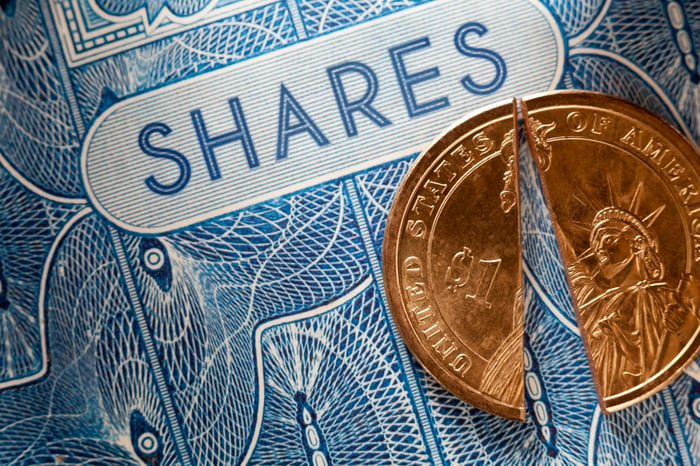Since this year began, the iconic Dow Jones Industrial Average, benchmark S&P 500, and innovation-propelled Nasdaq Composite have all reached multiple record-closing highs. While excitement surrounding artificial intelligence (AI) has played a key role in sending the broader market higher, stock-split euphoria has been equally important.
A stock split allows publicly traded companies to adjust their share price and outstanding share count, all while having no impact on their market cap or underlying operating performance.

Image source: Getty Images.
Although there are two types of stock splits, investors tend to gravitate to one far more than the other.
The less popular of the two are reverse stock splits. This type of split is geared at increasing a company's share price, usually to ensure that it continues to meet the minimum listing standards of a major stock exchange. Since reverse splits are often conducted by struggling businesses, they typically require a lot of extra vetting by investors.
On the other hand, investors absolutely flock to companies completing forward splits. This is the type of split that top-tier businesses undertake that makes their shares more nominally affordable for everyday investors who don't have access to fractional-share purchases with their broker. Over the last eight months, more than a dozen prominent businesses have completed a split, and all but one was of the forward variety.
A study by Bank of America Global Research found that companies conducting forward splits have more than doubled up the S&P 500 since 1980, based on returns in the 12 months following a stock-split announcement (25.4% for the splits versus 11.9% for the S&P 500).
This relatively steady outperformance for stock-split stocks is what has investors eager to guess which prominent company will be next to join this exclusive club.
With earnings season kicking into high gear, there's one market leader set to report this week that appears primed to announce a forward split.
This market leader can end October with a bang -- and its first-ever stock split
Among the multitude of industry leaders spilling the beans on how well or poorly they did over the last quarter, the one worth paying closest attention to is social media goliath Meta Platforms (META 2.43%). The company is the parent of Facebook, Instagram, WhatsApp, Facebook Messenger, and Threads, among other sites, and it's set to unveil its third-quarter results after the closing bell on Wednesday, Oct. 30.
One of the more interesting things about Meta, which is one of the members of the "Magnificent Seven," is that it has never conducted a split. This is noteworthy given that its shares touched $600 on an intraday basis during October. Even though more online brokerages than ever are allowing investors to buy fractional shares, Meta is a well-known company that may be pricing some retail investors out of buying its stock.
Aside from its share price hitting an all-time high in October, many of Wall Street's top-notch AI stocks have completed a split within recent memory, including:
- Graphics processing unit (GPU) leader Nvidia completed a historic 10-for-1 split in June.
- AI networking solutions provider Broadcom oversaw its first-ever split, also 10 for 1, in mid-July.
- Rack server and storage solutions specialist Super Micro Computer undertook its first split in history, 10 for 1 as well, in late September.
If the lens is widened a bit, other key artificial intelligence players -- such as Amazon and Alphabet, which are both Magnificent Seven constituents -- split their shares in 2022.
It has almost become an expectation that high-flying AI stocks will generate investor buzz by splitting their shares. Given that Meta is spending over $10 billion to purchase artificial intelligence GPUs from Nvidia for its data center, it certainly qualifies as one of Wall Street's top AI stocks. If it were to announce its first-ever forward split this week, it would undoubtedly be the most-anticipated split of the fourth quarter.

Image source: Getty Images.
Don't overlook the simple stuff -- it's what makes Meta such a great investment
While Meta Platforms' AI and metaverse ambitions are what have fueled the company's stratospheric comeback over the last two years, it's important for investors not to overlook the simple stuff that has made it such a highly profitable business.
For example, Meta attracted 3.27 billion daily active users to its family of apps during the June-ended quarter. Businesses are well aware that no other social media platform offers them access to as many eyeballs as Meta, which is what allows the company to command exceptional ad-pricing power.
To build on this point, Meta takes advantage of the non-linearity of the economic cycle. Although recessions are both normal and inevitable, the most important aspect of downturns is that they're short-lived. Out of the 12 U.S. recessions since the end of World War II, nine have resolved themselves in less than 12 months, and the remaining three failed to surpass 18 months in length.
With most periods of growth lasting multiple years, ad-driven businesses like Meta (it generates around 98% of net sales from advertising) are able to thrive.
Meta Platforms is also swimming with capital and generating boatloads of cash. Mark Zuckerberg's company closed out June with $58.1 billion in cash, cash equivalents, and marketable securities, and has generated around $23.4 billion in free cash flow (FCF) through the first six months of 2024. The key point is that, unlike most other social media companies, this cash and FCF give it the luxury of taking risks and being aggressive with innovation.
Lastly, investors should recognize that Meta is still reasonably cheap. Despite more than sextupling from their 2022 bear market low, shares of the company are valued at 23 times forecast earnings per share (EPS) for 2025. With sustained double-digit EPS growth expected over the next five years, a stock split could be the icing on the cake.





